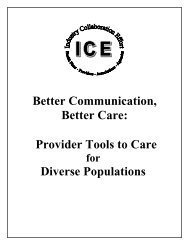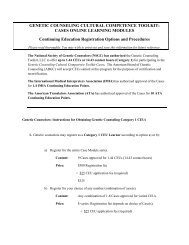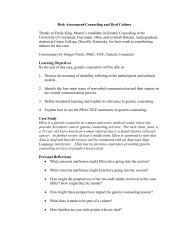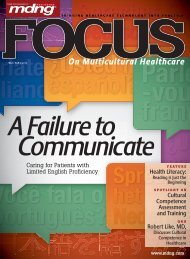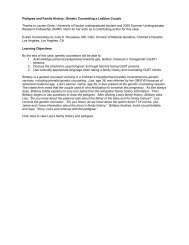Advanced Effective Communication, Cultural Competence, and ...
Advanced Effective Communication, Cultural Competence, and ...
Advanced Effective Communication, Cultural Competence, and ...
Create successful ePaper yourself
Turn your PDF publications into a flip-book with our unique Google optimized e-Paper software.
A Roadmap for Hospitals<br />
Chapter One: Admission<br />
• Contact the Speech Language Pathology Department,<br />
if possible, to provide the appropriate AAC resources<br />
needed to help a patient who has a communication<br />
impairment due to a current medical condition.*<br />
• Note the sensory or communication need <strong>and</strong> mention<br />
any personal aids or devices, auxiliary aids or resources,<br />
or AAC resources in the medical record <strong>and</strong><br />
communicate these needs to staff.<br />
❑ Determine whether the patient needs<br />
assistance completing admission forms.<br />
Over 40% of adults have significant literacy challenges,<br />
<strong>and</strong> 88% of adults have less than “proficient” health<br />
literacy skills [3]. Recognizing that a patient needs help<br />
reading or completing admission forms can be a sensitive<br />
issue <strong>and</strong> staff should obtain necessary information<br />
without embarrassing the patient.<br />
• Pay attention to clues to identify a patient with limited<br />
or low literacy (for example, statements like, “I forgot<br />
my glasses,” “My spouse usually keeps all this<br />
information at home,” or “Can I take this home to fill<br />
out <strong>and</strong> bring it back later?”) <strong>and</strong> respond with<br />
appropriate help.<br />
• Ask the patient, “Would you prefer to have someone<br />
help you fill out the forms?”<br />
• Offer the patient an opportunity to complete<br />
admission forms alongside a staff member.<br />
❑ Collect patient race <strong>and</strong> ethnicity data in<br />
the medical record.<br />
Hospitals must collect patient-level demographic data on<br />
race <strong>and</strong> ethnicity to identify the needs of individual<br />
patients <strong>and</strong> to eliminate disparities in the patient<br />
population. These critical data provide hospitals with<br />
information on the potential cultural needs of each<br />
patient, as well as an opportunity to monitor <strong>and</strong> analyze<br />
health disparities at the population level. †<br />
• Ensure that the patient underst<strong>and</strong>s why race <strong>and</strong><br />
ethnicity data are being collected. The Health Research<br />
<strong>and</strong> Educational Trust recommends that staff explain<br />
to the patient, “We want to make sure that all our<br />
patients get the best care possible, regardless of their<br />
race or ethnic background. We would like you to tell<br />
us your race or ethnic background so that we can<br />
review the treatment that all patients receive <strong>and</strong> make<br />
sure that everyone gets the highest quality of care” [4].<br />
• Allow the patient to self-report race <strong>and</strong> ethnicity<br />
information.<br />
• Respect the patient’s choice to decline to provide race<br />
<strong>and</strong> ethnicity information.<br />
• Refer to hospital policies <strong>and</strong> procedures for collecting<br />
patient demographic data.<br />
❑ Identify if the patient uses any assistive<br />
devices.<br />
A patient may arrive at the hospital with any of a number<br />
of devices that he or she uses to assist with activities of<br />
daily living <strong>and</strong>/or mobility. It is important for the<br />
hospital to make accommodations <strong>and</strong> make sure that the<br />
patient has access to these devices during care.<br />
• Make sure that any needed assistive device (such as a<br />
service animal, cane, walker, wheelchair, or another<br />
mobility device) is available to the patient throughout<br />
the continuum of care.<br />
• Identify whether specialized equipment should be used<br />
during the care of any patient with mobility needs.<br />
❑ Ask the patient if there are any additional<br />
needs that may affect his or her care.<br />
Although many of the preceding points have addressed the<br />
identification of patient needs, there may be additional<br />
issues (such as cultural, religious or spiritual, mobility, or<br />
other needs) that would require staff to coordinate<br />
services, incorporate specialized equipment, or record<br />
supplementary information in the patient’s medical<br />
record. ‡<br />
• Ask a general question, “Is there anything else the<br />
hospital should be aware of to improve your care<br />
experience?”<br />
• Identify whether the patient has cultural- or religionbased<br />
modesty issues regarding care provided by staff<br />
of the opposite sex.<br />
• Determine if there are certain garments or religiously<br />
important items that need to be worn.<br />
* See Chapter 6: Organization Readiness: Provision of Care, Treatment, <strong>and</strong> Services (page 41) for additional information on providing<br />
augmentative <strong>and</strong> alternative resources.<br />
† See Chapter 6: Organization Readiness: Data Collection <strong>and</strong> Use (page 36) for more information on the collection of patient race <strong>and</strong> ethnicity data.<br />
‡ See Chapter 6: Organization Readiness: Data Collection <strong>and</strong> Use (page 37) for more information on the collection of additional patient data.<br />
11



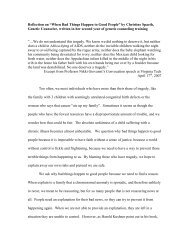
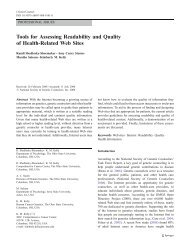

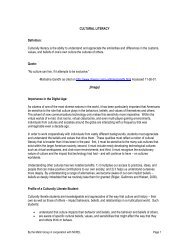
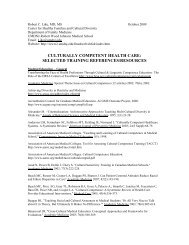

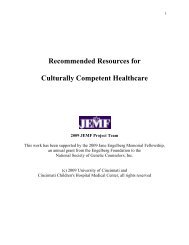

![Breaking Bad News PPT[1] - Genetic Counseling Cultural ...](https://img.yumpu.com/35003134/1/190x146/breaking-bad-news-ppt1-genetic-counseling-cultural-.jpg?quality=85)
